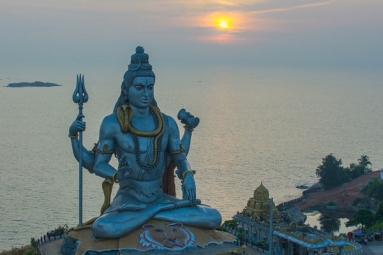These Are the 10 Countries Which Will Have Largest Hindu Population by 2050
May 13, 2019 11:59
With a global following of over 1.032 billion people, Hinduism is one of the world’s major religions. Hinduism originated in India, is believed to be the oldest one in the world.
Most Hindu followers are located in Asia with the United States, the United Kingdom, and Canada having the largest Hindu population outside Asia.
The report by Pew Research Center, a fact tank, showed the projections of the countries with the largest Hindu Population in 2050.
India
In India, Hindus comprise 80 percent of the entire population. India accounts for 94.3 percent of the total Hindu population in the world with over 973.75 million Indians practicing Hinduism in 2010.
In the year 2050, the Hindu population in India is projected to record a 25 percent increase to reach 1.297 billion followers who will account for 93.8 percent of the global Hindu population. The Muslim population is expected to grow faster than the Hindu population recording a 76 percent increase.
The PEW Research Center forecasts that Hindus will account for 80 percent of the total Indian population in 2050.
Nepal
Nepal has over 81 percent of citizens practicing Hinduism. It has second largest Hindu population in the world with its Hindu population being estimated to be around 24.17 million people (2010 estimates) representing 2.3 percent of the global Hindu population.
The majority Hindu in Nepal is expected to go on into the future with projections from the PEW Research Center predicting a Hindu population of 38.12 million in the year 2050 translating to a 36.6 percent population increase. Nepal Hindu population in 2050 is projected to represent 2.8 percent of the world’s Hindu population. The increase in population will be attributed to the current demographic analysis where children below the age of 14 make up 36.2 percent of Nepal’s Hindu population. Hindus in Nepal have the second lowest median age of 21 years.
Bangladesh
Hinduism is the second-largest religion in Bangladesh behind Islam with over 12 million residents or 8.5 percent of the total national population identifying as Hindu. Hinduism in Bangladesh has experienced a rapid decline over the past century.
The percentage of Hindus in the total population is expected to shrink even further in the future. However, the projections show that by 2050, the population of Hindus will have increased to about 14.47 million people.
Indonesia
With around 4.05 million Hindus, the Hindu population in Indonesia is the fourth-largest in the world. The records from the Indonesian Ministry of Religious Affairs put the number of Hindus in the country at about 10 million individuals. Hindus comprise 0.4 percent of the total population of Indonesia making Hinduism a minor religion in the country. Bali makes up the majority of Hindus in the country with 83.5 percent of Bali residents being Hindu.
By the year 2050, the relative percentage of Hindus will experience a rapid decrease, and while the people with belief in Hinduism will have increased to reach 4.15 million people, the country will have a dip in rank from having the fourth largest Hindu population in 2010 to having the sixth largest in 2050.
Pakistan
Pakistan has a population of 3.33 million Hindus who account for 0.3 percent of the global Hindu population. The religion is the second largest in Pakistan after Islam. Majority of Pakistan’s Hindu population is situated in the Sindh province. Nevertheless, years of ill-treatment led to the religion to experience a steady decrease over the past 50 years with an estimated 4.7 million Hindus moving to India in the mid-20th century.
According to the report by Pew Research Center, by 2050, the Hindu population will have grown to 5.63 million.
Sri Lanka
Hinduism is a minor religion in Sri Lanka with only 12.6 percent of all citizens following Hinduism with the huge majority situated in the central and northern regions of the country. In 2010, Sri Lanka had the sixth largest Hindu population in the world with its 2.83 million Hindus accounting for 0.3 percent of the world’s Hindus.
The religion is facing a steady diminution with Hindus migrating out of the country in their millions in the mid-20th century. By 2050, the total Hindu is projected to reach 3.43 million.
United States
As of 2010, the United States has been the largest Hinduism followed nation outside Asia with a total Hindu population of 1.79 million which was the seventh largest in the world and accounted for only 0.2 percent of the global Hindu population. American Hindus account for about 1 percent of the nation’s population making the Hinduism a minority religion in the United States.
According to Pew Religious Center, by the year 2050, the American Hindu population will have grown to 4.78 million people as more Americans embrace the religion.
Malaysia
Hinduism is a minority religion in Malaysia with only 6.3 percent of the population (about 1.78 million people) identifying as Hindus.
By 2050, the Hindu population in Malaysia will have grown by 24 percent to reach about 2.27 million Hindus. This projected growth in Hindu population in Malaysia is attributed to the high fertility rate among Hindu women.
United Kingdom
The United Kingdom has the second-largest Hindu population outside Asia behind the United States with 890,000 Hindus. The religion is the fourth largest in the country with 1.5 percent of the total population being Hindu.
Dissimilar to many other countries, the Hindu population in the United Kingdom has recorded momentous growth over the years and is expected to reach 1.37 million individuals by 2050.
Canada
As per records from the 2011 census, Canada has been named the second largest country in North America with 498,000 Hindus. The religion is a minority with Hindus accounting for only 1.45 percent of the total Canadian population.
Over the past century, Hinduism has experienced a rapid growth attributed to an influx of immigrants from South-East Asia in the late 20th century. According to the estimation, by 2050, the Hindu population in Canada will have grown to reach 1.07 million people.
By Sowmya Sangam

















